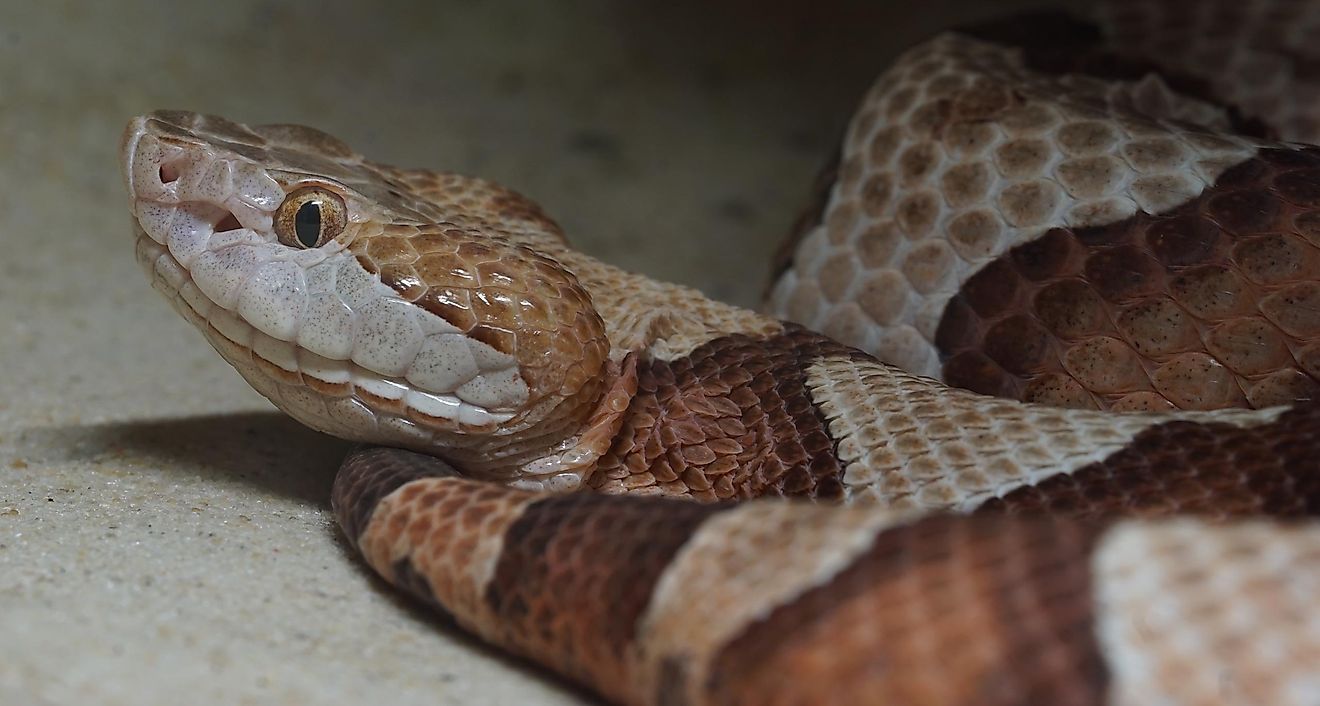10 Facts About The Copperhead Snake

The Copperhead Snake (Agkistrodon contortrix) is one of the most common snake species in North America. Their venom is relatively weak, and the bites rarely end up fatal for people. Still, they bite frequently, so here are ten facts about the Copperhead snake if you ever come across one.
Color
As the name tells us, the head of the Copperhead is in vibrant copper-red color. Copperhead Snake is a pit viper, and another characteristic of that species is that they have a small pit between the eyes and the nostrils, which serves as a heat-sensor. They use that pit to detect warm-blooded animals before they strike.
Size
Copperheads are medium-sized snakes, with their length being around 2 or 3 feet. Females are a bit longer than males, but males have longer tails. Their bodies are pretty thick and sturdy.
Head Shape
The head of a Copperhead snake is in the shape of a triangle. There is a noticeable ridge that separates the top of their heads from the eyes and nostrils. The pupil of a Copperhead is in a vertical position, and the color of the iris is mostly orange but can be in a reddish-brown shade.
Scaled Body Pattern
Like many of the other snakes, Copperheads also have scales over their bodies. The ''dorsal pattern", where every scale is in the shape of an hourglass, changing colors from dark and red shades of brown on the top, and more lighter-pinkish colors on the back. Those scales are typically more prominent on each of the snake sides, and they become more narrow as they come towards the center or the end of the snake.
Many other snakes that are not venomous have a very similar pattern, but remember, Copperhead is the only snake that has scales shaped like an hourglass! The head of an adult Copperhead snake, however, does not have the same scaled ornamentations.
Until they reach the adult stage, young Copperhead hatchlings body patterns are grayer than anything else, and the top of their tail is in very bright yellow or green shades.
Copperhead Territory
The Copperhead snakes can be found anywhere across the southern parts of New England, all the way up to the northern parts of Mexico. They are five distinct subspecies of the Copperhead, based on the location where they live. The northern specimens, which occupy the territories of Alabama, Massachusetts, and Illinois, cover the most area.
Mostly found in wooded areas, they are also quite capable of living in other types of ecosystems and can appear in more urban areas. They can survive in rock covered areas, deserts and canyons, and basically, any setting that has both sunlight and shade.
Copperhead's Social Life
Copperheads are a semi-social snake and most commonly do their prey hunting alone. However, they always hibernate within a snake pit or den. They like to return to the same den every year.
Copperheads like to hunt during the daytime in spring or fall. Still, when the summer comes, they turn into night-loving animals and catch prey using their heat-sensor. They usually leave their den in the late spring and go searching for food. They come back to hibernation in early fall. Copperheads prefer humid and warm environments, and can sometimes climb trees when searching for prey.
The Hunter's Way
Copperheads are, in essence, predators. They mostly sit and wait and catch small prey bursting out of a bush. When they engage in a battle with bigger prey, they first bite the animal and release it. They know the venom is going to kick in soon, so they track down the victim.
Like most of the snake species, the Copperheads eat their prey whole, utilizing the flexibility of their hinged jaws. Interestingly, Copperheads eat only up to 12 times a year.
The Young Hunter's Alternative
Young Copperheads do not have the same strengths to tackle large prey as adults, so their diet consists mostly of smaller insects. The young ones are especially good at catching caterpillars. In hunt mode, a young Copperhead lays perfectly still, with only the very top of their tail moving and attracting animals like lizards or frogs. Once the prey comes close enough, they strike because they are born with the same set of fangs and the ability to inject venom.
Mating Season
The time when Copperheads engage in mating rituals is usually between February and May, and other rounds happen from August to October. To grab the female's attention, male Copperheads fight between themselves in a body-shoving contest. A male that loses a fight is likely never to rechallenge another male.
Females can also engage in combat to find their partner, and they will always turn down the male that does not want to put on a fight with her. After the mating, the female can delay fertilization for a few months, storing the sperm until the hibernation period is over.
Ovoviviparous Species
After the mating, the eggs incubate within the female. The little Copperheads are born alive, and a female Copperhead can give birth up to 18 young ones. The venom found in hatchlings is as potent as the one found in adults.











